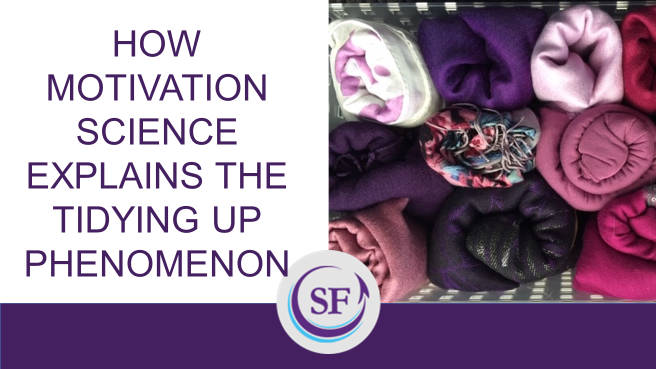If you haven’t heard of Marie Kondo’s tips for tidying up, perhaps you’ve been too buried under piles of clutter to notice. I’m only partly joking.
“The Life Changing Magic of Tidying Up: The Japanese Art of Decluttering and Organizing” has sold more than 8 million copies worldwide. With over 9,000 five-star reviews on Amazon for the English-language version, a hit show on Netflix, and articles, blogs and commentaries by pundits, psychologists and professional organizers attempting to explain the phenomenon, it’s hard to ignore the success of the diminutive whirlwind whose English still requires a translator and subtitles.
I discovered Kondo’s book several years ago and it didn’t take long to deduce why I fell under her spell. Kondo’s KonMari approach to organization aligns perfectly with the science of motivation. Every human being thrives when three psychological needs are fulfilled: choice, connection and competence*. If you are hoping to generate more energy in the new year, your best bet may be creating choice, connection, and competence by using Kondo’s approach to tidying up. Let me explain.
Tidying up creates choice
Kondo encourages you to empty your drawer, closet or whatever you need to organize into one big pile. Just seeing that daunting pile instantaneously generates mindfulness and creates the urge to purge! Mindfully, you regard each item.
People have written plenty of sarcastic and snarky remarks about Kondo’s idea of noticing how each item makes you feel. (Seriously, is a sock supposed to spark joy? More on that in a moment.) The point here is that Kondo encourages you to mindfully make choices about each item. She provides criteria to help you make your decision about whether to keep, give away, sell or toss. I personally felt empowered and emboldened by consciously and conscientiously choosing what to do with each item. Creating choice is one-third of the triumvirate of psychological needs underlying optimal motivation.
Tidying up creates connection
The answer to “Is a sock supposed to spark joy?” is yes. This seemingly trivial issue is actually a great example. I had a drawer full of never-worn, over-worn, mismatched, and “maybe I’ll need them someday” socks. Every time I opened that sock drawer, I felt a sense of dread. I never threw away an unmatched sock, thinking I’d find the missing mate behind the dryer one day. Using Kondo’s approach, I tried each pair with the appropriate shoes. I donated 99% of those socks to Goodwill. (By the way, thrift shops have seen an increase in donations and are crediting it to Kondo’s influence!)
Giving away good socks that weren’t good for me felt so good, I didn’t despair having only a few pairs left. That’s when I discovered Bombas — the high-tech sock company whose socks fit and do what a great pair of socks should do! As if that weren’t enough, Bombas donates a pair of socks to the homeless for every pair you buy. For the first time, I was wearing socks that literally sparked joy as I walked!
Finding meaning by mindfully choosing the socks I wore sparked more than joy — it ignited my motivation to exponentially create connection through my worldly possessions. What really set my motivation on fire, though, was how Kondo’s approach helped fulfill my third psychological need for competence.
Tidying up creates competence
I didn’t even need to walk in my Bombas socks to experience a deep sense of satisfaction. A full drawer of unwearable socks became a small bin full of wearable ones. And the drawer that housed the socks now houses chosen things that had been residing in obscurity.
Never underestimate the power that comes from being able to effectively manage your everyday life. If you watch verified user testimonial videos on Amazon, you witness that what makes people giddy is learning the KonMari methods for folding clothes to stand up vertically, organizing according to function and size, and storing items so they are aesthetically pleasing. (The photo in the graphic is one of my scarf bins!) Tidying up, it turns out, is a skill that can be learned; it doesn’t come naturally.
Marie’s techniques for making meaningful decisions on what to keep, donate, or toss, create choice and connection — two of the psychological needs for generating the optimal motivation required for you to thrive. But the magic happens when you learn the skills necessary to organize your space, sparking the joy of creating competence — fulfilling all three psychological needs.
As experts ponder the success of Marie Kondo’s KonMari approach, I hope you’ll experience it for yourself, validate what we know about motivation science, and find ways to mindfully create choice, connection, and competence in other aspects of your work and life.
*Motivation science refers to the three psychological needs as autonomy, relatedness, and competence. To promote understanding and ease of translations, I refer to the needs in my book “Master Your Motivation” as choice, connection and competence.
Susan Fowler implores leaders to stop trying to motivate people. In her latest bestselling book, she explains “Why Motivating People Doesn’t Work … And What Does: The New Science of Leading, Engaging, and Energizing.” She is the author of bylined articles, peer-reviewed research and six books, including the best-selling “Self Leadership” and “The One Minute Manager” with Ken Blanchard. Tens of thousands of people worldwide have learned from her ideas through training programs, such as the Situational Self Leadership and Optimal Motivation product lines. For more information, visit SusanFowler.com.
If you enjoyed this article, sign up for SmartBrief’s free e-mails on leadership and career development, among SmartBrief’s more than 200 industry-focused newsletters.
